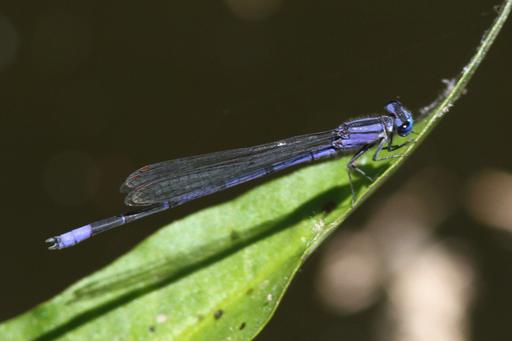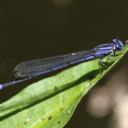
United States and Canada
The face of the male is violet or blue-violet. The top of the head is black with a violet occipital bar and postoccipital spots that are usually confluent with one another. The middorsal thoracic carina is black. The black middorsal stripe is a third as wide as the mesepisterna. The violet antehumeral stripe is 1/2-2/3 the width of the middorsal stripe. The black humeral stripe is half the width of the antehumeral stripe for most of its length. The rest of the pterothorax is pale. The legs are pale blue with black stripes on the femora and tibiae. The tarsi are dark. The pale areas of the abdomen are bluish-violet often becoming pruinose on the basal segments. Segment 1 is black on the basal 1/3-3/4 of the semgnet dorsally. There is a variable dark spot dorsally on segment 2. Segments 3-4 each have a dark spot on the apical fifth of each segment dorsally. Segment 5 varies dorsally from a small dark spot to a full-length dorsal stripe. Segments 6-7 each have a nearly full-length dorsal stripe. Segments 8-9 are blue-violet and segment 10 is black dorsally. The cerci are noticeably longer than segment 10. The paraprocts are short, 1/5 the length of the cerci. The head and thorax are similar to the male. The mesostigmal plates are flat with an oval swelling medially on the posterior margin. The middle lobe of pronotum lacks distinct pits. Abdominal segment 1 is similar to the male. Segment 2 bears a full-length black stripe dorsally. Segment 3 has a black spot in the distal 1/5 of the segment and a narrowed stripe in its basal 2/3; these spots a re generally connected by hairline. Segments 4-5 are generally as in the male. Segments 6-7 each have a full-length dorsal black stripe and pale apical ring on 7. Segment 8 is pale dorsally. Segment 9 is black with pale ventrolateral margins and 10 has an irregular black dorsal stripe.
Size: Total length: 29-33 mm; abdomen: 23-27 mm; hindwing: 15-24 mm.
Similar Species (south-central US): Neotropical Bluet (E. novaehispaniae) is similar but is generally smaller in size and lacks black on the lateral portions of segments 9-10. Arroyo Bluet (E. praevarum) has a diamond-shaped black spot dorsally on segment 2.
Habitat: Ponds.
Natural History: This Mexican species was only recently discovered in New Mexico and is still only known from a single location in in the region. M. Molles collected a male at Bosque del Apache at a Tamarix flood site in 1994. The larva of this species remains undescribed and its general biology undocumented.
Distribution: Arizona and New Mexico south through Mexico to Guatemala.
Source: Abbott, J.C. 2006-2010. OdonataCentral: An online resource for the distribution and identification of Odonata. Available at OdonataCentral.
Edited by Drew Weber (9/24/2015).
